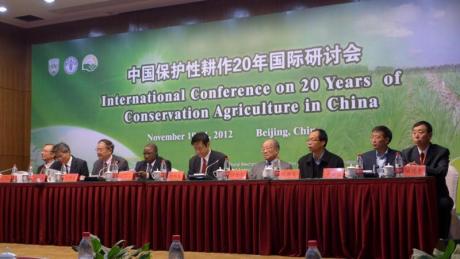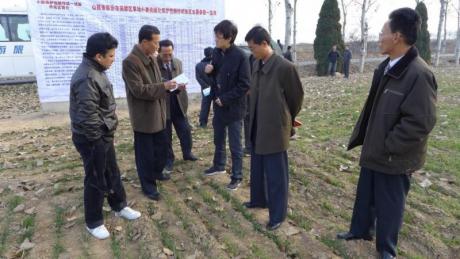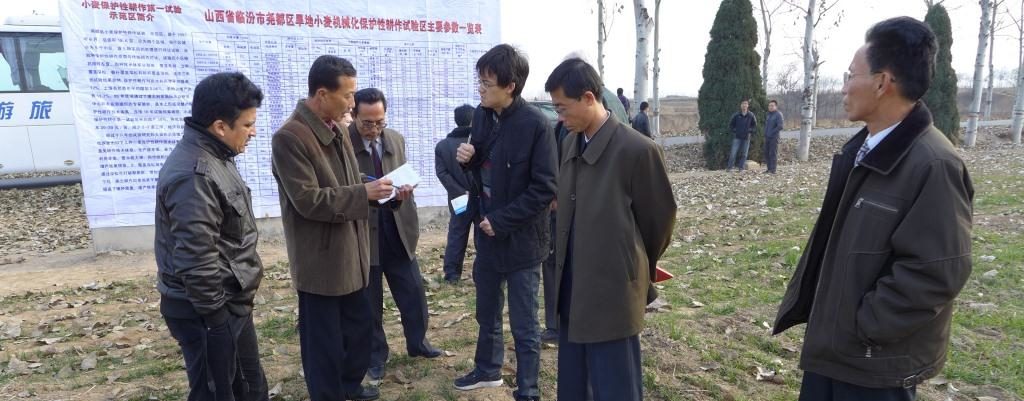In 1992, China started a comprehensive research program into conservation agriculture (CA) and by 2009, China had adopted a national plan for CA and thereby seriously and deliberately taking steps in progressing conservation agriculture. By 2012 China was applying CA on more than 6 million hectares (approximately 5% of cultivated land in China) according to Li Hongwen, Professor at the Conservation Tillage Research Center in Beijing.
The conference “20 years of conservation agriculture in China”, gathered 110 CA experts from 15 countries around the world to discuss progress of CA in China, in November 2012. At the conference were six representatives from Academy of Agricultural Sciences from the Democratic People’s Republic of Korea (DPRK) facilitated by Concern Worldwide. Concern Worldwide´s Food, Income and Market (FIM) programme in DPRK is actively supporting an integrated development approach were CA, sustainable utilization of sloping land (550,000 hectare in DPRK) and food processing, aims at reducing food insecurity.
 The high table at the “20 years of conservation agriculture in China” conference, Photo: Bo Lager
The high table at the “20 years of conservation agriculture in China” conference, Photo: Bo Lager
‘Conservation agriculture is an opportunity to increase sustainable development of agriculture in China now and in the future’, says Professor Hongwen. ‘China must be in the forefront of promoting intensified sustainable agricultural practices since it only has 7% of global arable land but 22% of the global population’. The future global climate change and food security scenarios are overwhelming considering that the world population will be reaching 9-10 billion in 2050. It is estimated that China need to double their food production by 2050.
Agriculture status in China
Despite the progress of CA, China and the DPRK still rely to a large extent on conventional (tilled) agriculture. Conventional agriculture and the green revolution in the 60s and 70s dramatically increased food production in Asia and doubtlessly improved the livelihoods of millions of people in Asia and in particular China, but the advances have also come at a cost. Conventional tillage in combination with very high dosages of synthetic fertilizers and pesticides (Chinese farmers used six times more nitrogen fertilizer than an American famer) has led to soil erosion, decreasing soil organic carbon, water run-off and nutrition leakages resulting in contamination of groundwater and decreased yields. Nitrogen fertilizer induced crop yield peaked in the early 2000s in many parts of China and today agricultural land is over fertilized. During 2007/8 the country was the top consumer of nitrogen fertilizer worldwide, using 32% of global nitrogen. Research demonstrates that enhancing nitrogen use efficiency would be more effective than increasing nitrogen inputs for sustaining China’s food demand.
What is CA?
CA involves minimum (or zero) tillage; keeping the crop field permanently covered with crop residues between harvesting and planting. Beside the positive effects for the climate and increased food security it also prevents soil erosion (between 50-80%) and substantially reduces the labor requirement while increasing biodiversity. These effects are all very desirable by especially smallholder farmers around the world. CA not only reduces emission of carbon dioxide to the atmosphere, it also helps farmers to adapt to climate change while at the same time mitigating climate change through carbon sequestration. Therefore, CA is the future for China and the world, a technology that secure sustainable production of foodstuffs in the future. CA is possible on a large portion of agricultural land worldwide; this is proven in US who started to develop the technology in the 30s. Australia has adopted CA nationwide and through good extension and on-farm demonstration sites now has 90% of their agricultural land under CA, says Jeff Tullberg, one of the speakers at the conference, he is further arguing, “In CA, we work with the soil not against”.
Why CA?
Research has proven that CA can reduce labor input with up to 100% on some crops. Because crop residues are incorporated in the soil instead of being used as fodder or just burnt, is decreasing the requirement of artificial fertilizer application. CA also retains moisture more efficient in the soil than conventional agriculture. Another important effect of CA is more efficient utilization of water, an environmental service that is becoming scarcer in China. Professor Hongwen tells us that the groundwater table in Beijing area is sinking by one meter per year because of unsustainable utilization. Government subsidies (30%) on CA machinery in China are further increasing the profitability of the practice. CA technology in Nepal shows about 30% higher field capacity than farmer’s traditional practice according to Shreemat Shrestha from the Nepal Agricultural Research Council. If well adapted and supported (extension, information, credit facilities and mechanization) to local knowledge and practices, CA is the ultimate sustainable solution, and the future of agriculture.
CA in DPRK
Concern Worldwide is through its partners implementing CA in DPRK with financial support from EU and Irish Aid. The CA project is part of a wider support programme, which includes Water, Sanitation and Health (WASH) and Food, Income and Market (FIM) at local level in DPRK. Only about 17% (2 million hectares) of the land area is cultivated in DPRK. Chronic food insecurity is widespread in DPRK according to the FAO/WFP Crop and Food Security Assessment Mission (CFSAM), Nov 2012. Beside the negative social and health implications, food insecurity is also causing deforestation and land degradation in particular on sloping lands as people are looking for more land to grow food crops.
 Staffs from Academy of Agricultural Sciences (AAS), Democratic People’s Republic of Korea, are discussing CA with colleagues from Nepal and China during the conference field trip. Photo: Bo Lager
Staffs from Academy of Agricultural Sciences (AAS), Democratic People’s Republic of Korea, are discussing CA with colleagues from Nepal and China during the conference field trip. Photo: Bo Lager
DPRK government is supportive to CA and has since 2009 a policy, which promotes organic farming, mainly recycling of organic waste and human excreta through composting. CA is very appropriate technology in DPRK as it is one intervention that can mitigate chronic food insecurity.
Bo Lager – Concern Worldwide, Democratic People’s Republic of Korea
Biography
I currently work as the Programme Manager for Concern Worldwide in the Democratic People’s Republic of Korea (DPRK). My responsibility lies within Food security, Income and Market (FIM). During my whole career I have been working with agroforestry. From my MFS study in Laos 1991, “Farm level agroforestry at the Vientiane plan”. With an MSc in Agroforestry from University of Wales, Bangor, I firstly regard myself as an agroforester and in DPRK I will continue to promote agroforestry, conservation agriculture, climate smart agriculture, sustainable natural resource management and business development.
Previously, I worked as the Programme Director for Vi Agroforestry programme (Kenya, Tanzania, Rwanda, Malawi and Uganda) between 2006 and 2012. During my time in Vi Agroforestry I was promoting carbon finance in agriculture and agroforestry systems. I was responsible for the development of climate change adaptation and mitigation work within the Vi Agroforestry programme. I spearheaded two carbon finance schemes. One scheme, which was the first soil and agricultural carbon project “Kenya Agricultural Carbon Project” (KACP) in Africa is supported by World Bank with an Emission Reduction Purchase Agreement (ERPA) signed with the World Bank, and the BioCarbon Fund. This work involved developing a new methodology under Verified Carbon Standard (VCS), which has recently been approved (VM0017: Adoption of Sustainable Agricultural Land Management (SALM)). The SALM methodology quantifies the GHG emission reductions achieved through sustainable land management practices that enhance aboveground, belowground and soil-based carbon stocks linking 50,000 smallholder farmers in Western Kenya to the world carbon market.
